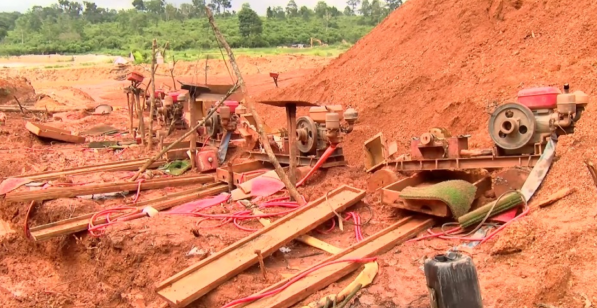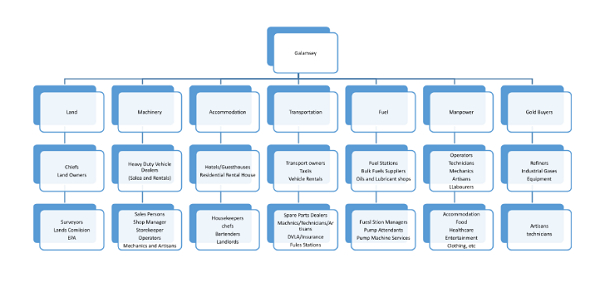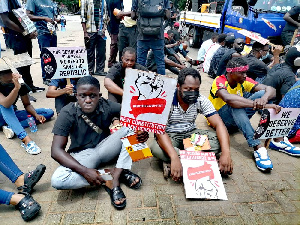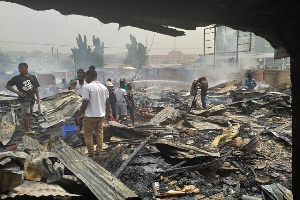Galamsey Economy: The good, bad and ugly

Illegal mining, popularly known as Galamsey, has been around for a long time, at least, in the early 90s, in places like Tarkwa-Nsuaem, Tarkwa, Bogoso and Obuase; however, not widespread as it is now.
Since 2013, Galamsey has become widespread and transformed into a lucrative illegal business, attracting people from all walks of life, and even foreign nationals from neighbouring countries, Chinese, Indians, and others.
Currently, Galamsey is predominant in the Western, Western-North, Ashanti, Eastern, Central Regions, and the Northern parts of Ghana.
Irrespective of the environmental hazards Galamsey activities pose to the host communities, its socioeconomic benefits cannot be overemphasized, as galamsey has become a lucrative source of employment and income, with other spillover benefits to the host communities.
Notwithstanding its illegality, Galamsey has proven to be a resilient force to be reckoned with, despite several government efforts to stop it, or regularize it where necessary. A 2020 report by the Ghana Chamber of Mines estimated that illegal mining accounts for over $2 Billion in lost revenue.
The actual number of people into Galamsey is unknown, however, it is estimated to have about 20,000 to 50,000 people engaged in various activities in Galamsey. The minister of information recently claimed there are now 200,000 people engaged in Galamsey, and other sources claim there are nearly 3 million who rely on it for their livelihoods.
Whiles illegal mining is not limited to Ghana, other countries such as DR Congo and Peru are also battling illegal mining activities in their respective countries.
The Havard Kennedy School, CARR Center for Human Rights Policy reported in their 31 January 2025 publication on its website, that there are over 450 illegal mining companies in the DRC due to lack of compliance with current Congolese mining codes.
NPR.org reported in their 2nd April 2024 publication on its website that, nearly 250,000 acres of the Peruvian Amazon have been destroyed, according to a 2018 study by Wake Forest University researchers.
It is regrettable to know that illegal mining is prevalent in most resource-rich countries. These numbers are alarming and requires and careful study to outline the good, bad and ugly aspects of this illegal activity.
The good
Galamsey has proven to be economically beneficial to owners, workers, and largely, the host communities. A typical example is Asankragwa and surrounding communities in the Amenfi-east, Amenfi-Cantral and Amenfi-West Municipals in the Western Region.
Since the introduction of Galamsey in these communities in the early 2014, there has been a massive economic improvement in these host communities. There has been a tremendous improvement in the livelihoods of the people directly engaged in the galamsey activities, such as land owners, concession owners, workers, with spillover benefits to traders, business owners and other individuals.
Galamsey has become a viable economic pillar, as it creates demand for manpower (labourers, artisan and technicians, caterers and other related human resources). A 2019 report by the International Growth Center (ICG) estimated that over 1 million people in Ghana are directly and indirectly employed in small-scale mining, including Galamsey.
Direct jobs include heavy and light machinery operators, drivers, security personnel, caterers, and equipment, fuel, transportation, accommodation, feeding, health services, labourers and security. Indirect jobs Machinery and equipment sale and rental businesses, works shops, fuel stations, transport business, hotels, residential and commercial rental buildings, supermarkets, safety shops, entertainment facilities, casinos, and other spillover businesses such as boutiques, beauty shops, electronic gadget shops, etc.
Galamsey requires the use of heavy machinery and equipment such as Excavators, Bulldozers, Bucket Loaders, crane trucks, heavy duty generators, water pumps and conveyors.
Demand for these have created several sales and rental shops, creating employment for storekeepers, artisan and technicians (mechanical and electrical) sales persons, machine operators and drivers. These heavy machinery and equipment require huge volumes of fuel to operate, therefore increasing the demand for petrol, diesel and other oils and lubricants.
This has led to the opening of more fuel stations and oils and lubricant shops, mostly owned by foreign nationals like the Chinese and Indians. Annual petroleum products consumption for 2021 was 4.64 million metric tons, as compared to 2.87 million metric tons in 2013.
With over 1 thousand excavators and other vehicles and machinery involved in galamsey activities, the significant impact of petroleum product cannot be overemphasized. Hence the rippling economic benefits to petroleum product suppliers. (Averagely, an excavator consumes 12 liters/hour of fuel)
These heavy duty vehicles, machinery and equipment requires regular maintenance, hence, a significant number of artisans and technicians (welders, mechanics and electricians) are needed to provide these services.
Galamsey site workers need a lot of food, therefore demand for groceries and food stuffs has increased due to the large number of labourers on site. This also demands the services of chefs and food service providers.
Due to its lucrativeness and general socioeconomic benefits, largely due to lower barriers to entry, immediate cash payments, many people migrate to these galamsey host communities.
Research by May Turolla and Lisa Hoffman on “Internal Migration in Ghana” published on 6th August 2023 on Taylor and Francis Online website, indicated that 18.1% of people migrate in search of jobs. This creates increase demand for basic human needs, such as accommodation, food, clothing, healthcare, recreation and entertainment.
As a result, there has been supply for these goods and services, therefore a vibrant market. Overall, galamsey activities has created a whole economy with interrelated demand a supply market, thereby improving the socioeconomic lives of the people in the host and nearby communities. A World Bank study found that small-scale mining contributes significantly to rural incomes in resource-rich arears.
Below is an illustration of the a “Galamsey Economy” with its interrelated economic factors and spillover benefits.

The bad
The socioeconomic benefits of galamsey cannot be stated without its potential adverse effects. Undoubtedly, galamsey activities have proven to have adverse impact on the environment, livelihoods, and the economy as whole, and national security.
Environmental Impact: the physical destruction of the environment, including farmlands, water bodies, and pollution is a major concern to all, and a threat to the livelihoods of the people in the host communities and the whole country as whole.
The BBC report on 9th October 2024 indicated an estimated 4,726 hectares of land destroyed by illegal mining in Ghana. It threatens food security, alternative livelihoods; there has been reports of destroyed cash crop farms, such as cocoa, rubber, cashew and other crop farms to mine gold on the land. This has destroyed the source of livelihoods for the affected farm owners.
Water bodies such as rivers, streams, lakes and lagoons have been destroyed due to galamsey activities, therefore affecting the supply of quality water for human consumption and irrigation of farms, and the destruction of aquatic life. A 2021 report by Water Resources Commission of Ghana revealed that over 60% of the country’s water are polluted due to illegal mining.
The natural ecosystem is not spared in the destruction, as 44 of Ghana’s forest reserves are affected by illegal mining, as reported recently by MyJoyOnline on 20th February 2025.
Air pollution, because of exhaust fumes from galamsey machinery, dust from stone mills and heavy trucks on untarred roads, wrongful disposal of chemicals and petroleum waste.
The vastness, remoteness and lack of access to these galamsey sites makes it difficult for the Environmental Protection Agency (EPA) to check and regulate the activities of galamsey, coupled with internal challenges such as budget constraints, understaffing, and logistics.
Health Risks: the use of chemicals in gold extraction is inevitable, however, when unregulated can pose dangerous health risks to miners, environment and lives. The use of chemicals such as mercury and cyanide pose a dangerous threat to health. According to the World Health Organization (WHO), mercury poisoning from small-scale mining affects thousands of miners and their families in Ghana.
Economic Losses: Though galamsey has proven to be economically viable, its benefits leave much to be desired. Economic benefits such as tax revenues, social security benefits, insurance and other levies which would have increased government revenues have eluded due to the unregularized nature of galamsay. The Ghana Revenue Authority (GRA) estimated that the government loses over $500 million annually in unpaid taxes from illegal mining.
Galamsey employs thousands of people, and these worked receive wages and salaries which are not taxed. Employee social security benefits are not paid, no insurance cover for workers, and other levies have eluded. All these could have increased government revenues, social security and insurance, therefore generally affecting the economy positively.
In addition to the economic woes of the local economy, the Chinese have created a local economy, trading amongst themselves, just like the Indians and Lebanese. The Chinese have opened their own hotels, restaurants and casinos, supermarkets and groceries. This has given the Chinese a resilient economic leverage over the indigenes of the host communities.
National Security: galamsey poses various national security threats, such as illegal possession and use of firearms. In his recent account of Ministry’s action on illegal mining in parliament, the Honorable Minister of Lands and Natural Resources, Emmanuel Armah Kofi Buah expressed his worries of illegal miners being armed with sophisticated weapons, therefore making military efforts to curb illegal mining activities difficult.
The Business and Financial Times reported on its website on 21st January 2025, a deadly clash between illegal miners and the military, at Anglogold Ashanti Mines, Obuasi, which resulted in the death of “7 illegal miners”. These illegal miners were armed with locally manufactured guns, knives, pump-action guns, and other weapons.
Also, rival illegal miners usually armed to protect their mining concessions which usually leads to clashes. A story by Akwasi Annim Agyei on Citi News Room website, on 24th March 2022 indicated a clash between two illegal mining rivals that resulted in the death of one and several others injured at Bonsaso, near Tarkwa in the Western Region.
Lessons can be taken from countries such as Sierra Leone and D.R Congo where illegal mining activities have been a haven for springs of rebel groups. As reported by Africanews.com on 3rd May 2024, rebel group M23 take control of a key mining town Rubaya in the DRC. The remoteness and vastness of galamsey sites could provide a secret haven for formation and training of rebel groups.
Also, there has been reported cases of several armed robberies on galamsey sites, gold buyers, and other related persons of interest. AN example is a case reported by Mordernghana.com on 14 January 2025 of a robbery 30 ounces of gold and GH¢11,000 from some miners in the Amansie South District. All these pose a security threat and if not checked, could escalate to uncontrollable levels.
The Ugly
Money, is said to be “the root of all evils”, though this saying remains debatable, one cannot ignore that fact that the need for money would make man do anything possible to have some.
This is evident in the mad rush for galamsey, regardless of its potential risks. Galamsey host communities have experience some level of socioeconomic developments, however, this has also come with several social vices and immoral activities, such as drug abuse and prostitution.
Drug Abuse: Due to the physical nature of galamsey activities, most site workers, such as machine operators, labourers and security guards tend to use illicit drugs such as, Indian hemp, energy drinks mixed with Tramadol, cocaine, heroin, and other chemicals.
It is believed these drugs gives them the much needed strength to about their daily activities. According to a study by the Ghana AIDS Commission, over 30% of miners in galamsey aras use illicit drugs. This has led to the peddling of illegal drugs on galamsey sites and host communities.
Also, it is alleged that some Over-the-counter chemical sellers are engaged in the supply of unapproved drugs such as Tramadol, Morphine and other strong sedatives.
Prostitution and Human Trafficking: Prostitution has become a very lucrative business in galamsey host communities, attracting sex workers from neighbouring countries. Also, child trafficking is common in mining areas due to cheap labour and exploitation.
2013 research by “Free the Slaves” indicated that boys as low as 12 years are engaged in mining activities, usually working with dangerous chemicals to extract gold. Also, girls as low as 10 years are engaged in prostitution in mining camps.
The International Organization for Migration (IOM) on human trafficking report on “Internal and Cross-Border Sex Trafficking in Ghana” in 2020 highlighted sex trafficking activities internally and cross-border, especially neighbouring countries.
A recent unannounced swoop on illegal structures hosting these sex workers revealed a substantial use of illegal drugs by the sex workers and even using superstitious means to attract male patrons, as published on the Ghanaian Times websites, 10 August 2022.
Crime Rates: Crimes such as robberies, possession of illegal arms and illicit drugs, and other criminal offenses have become common in mining areas. The Ghana Police Service reported a 25% increase in violent crimes in mining communities between 2018 and 2022. There are also rumors of ritual murders to attract gold and other superstitious activities for protection and other personal benefits.
All these has led to a significant decline in the moral standards of our communities, with more youths engaging in these social vices.
Conclusion
In conclusion, illegal mining as popularly known as Galamsey cannot be entirely demonized, considering the enormous socioeconomic benefits associated with it. In view of the above elaborations, government must engage all stakeholders in galamsey, develop a win-win policy.
This policy must seek to address issues like land administration, concession management, mining methodology and processes, land reclamation, alternative livelihoods, environmental protection and sustainability, resource management, immigration, permits, revenues, and all other factors that encompasses galamsey.
Reference can be made to Indonesia for its initiatives in regularizing artisanal mining through licensing and community-based initiatives. With the right working policy framework, government can derive so much economic benefits from galamsey.
Columnist: Michael Kwame Agbeze





